Pandemics of Our Own Making
We must address our broken relationship with nature
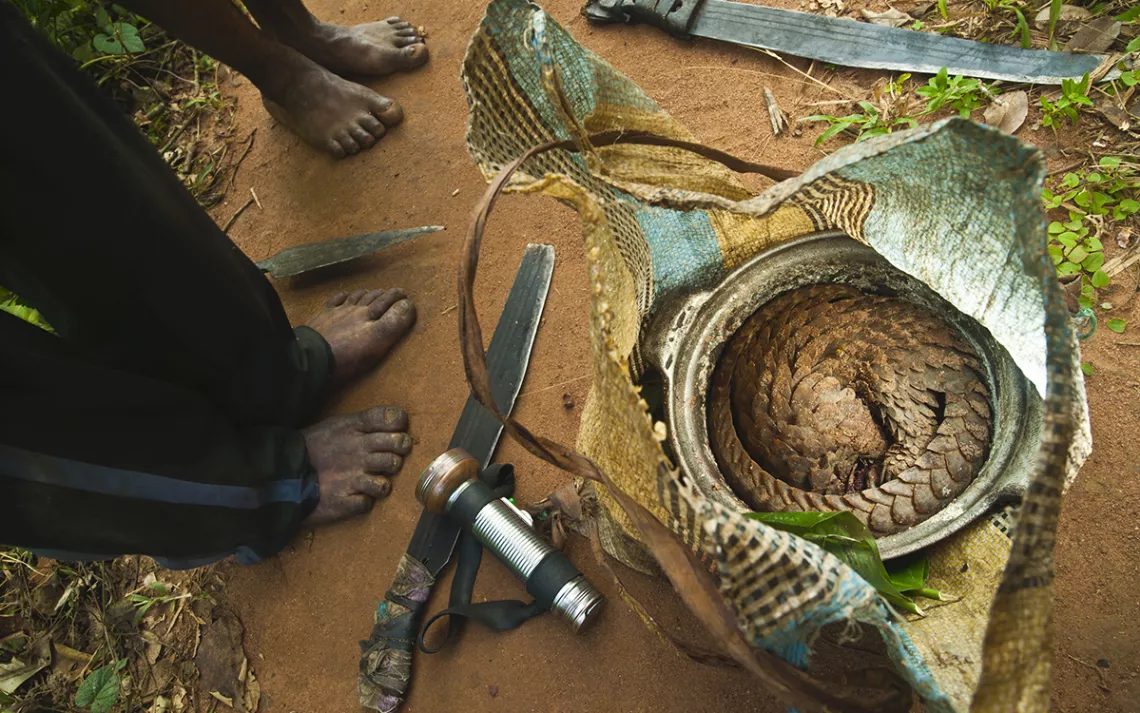
Pangolin captured by hunters en route to a market in the Central African Republic. | Photo by Jabruson
With the COVID-19 pandemic wreaking various forms of havoc around the globe, we’ve all had a lot of time to ponder not only how we got into this predicament but also how we might get out—and what we need to do to prevent future outbreaks.
Like much of the rest of the world, I’ve been social distancing for months, doing my best to minimize exposure and keep my family, friends, and community safe. But as a virologist who has spent her career studying the evolution of infectious diseases, I can’t help thinking about the bigger picture, about how our relationship with the natural world can have profound impacts—both positive and negative—not just on the health of our planet but on human health as well.
While I’m more passionate than ever about the work I do, I didn’t always want to be an infectious-disease biologist. My first love was the great outdoors. I imagined a life spent traipsing around a national park and inspiring that love in others. Then the theater captured my heart, and all I wanted to do was act. Finally, in college I had the opportunity to combine my passions for the natural world and the arts, running a theater program to promote community health in West Africa. That’s where my fascination with microbes began.
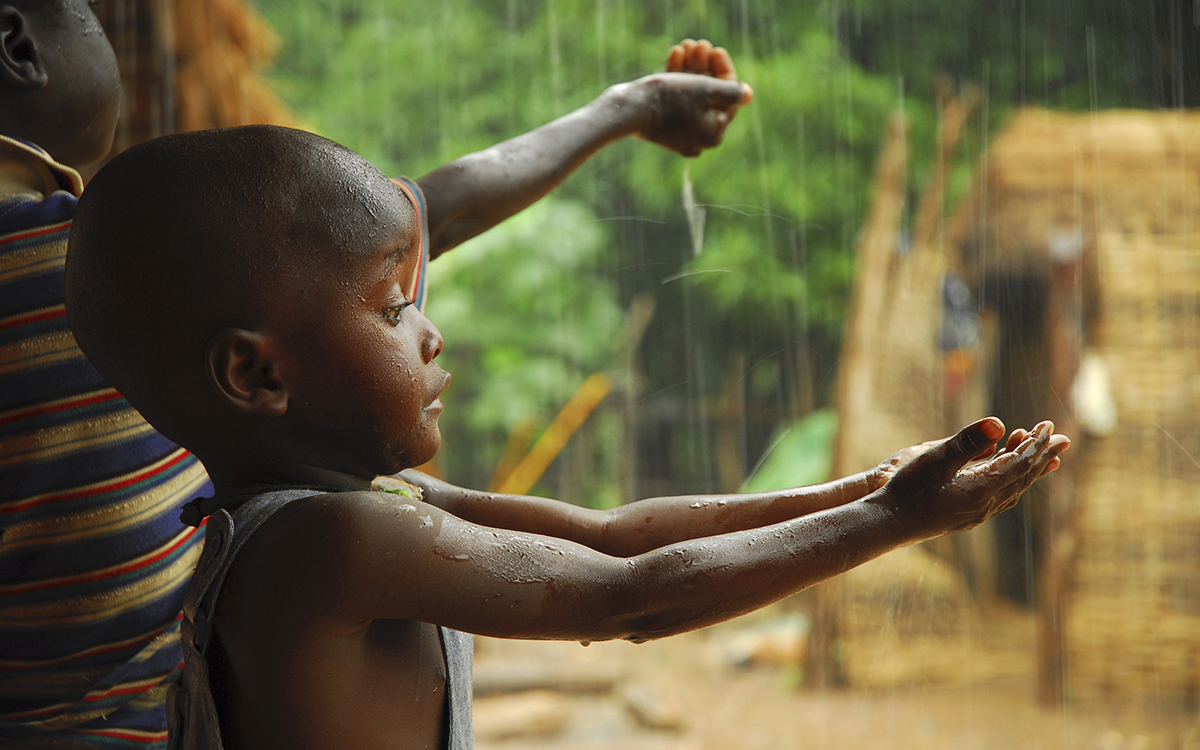
A child and mother catch raindrops in Basari County, East Senegal. | Photo by Enrique Lopez-Tapia
With antimalarial medication, insect repellent, and a well-stocked first-aid kit in hand, I arrived in Liberia for a summer volunteer stint teaching math by day and theatricizing with my troupe of students by night. Ironically, even while we told stories of disease prevention, and despite my best efforts to protect myself, within weeks I had contracted malaria (Plasmodium falciparum), amoebic dysentery (Entomaeba histolytica), and a staph infection (Staphylococcus aureus).
This trifecta of illness ultimately landed me under the care of nurses at, of all places, a leper colony (caused by Mycobacterium leprae, but I dodged this one). There I slowly regained my strength and then remained in hiding at the most shunned of places just as the first attempted coup of the Liberian civil war began. Ironically, the parasites in my system had quite literally saved my life. But it was the diverse kinds of microbes and the ways in which they had breached my defenses and affected me physically that captured my imagination.
*
Although the three pathogens that infected my body all those years ago come from different branches on the tree of life, I would discover that they have some interesting things in common: They themselves and/or their recent ancestors all circulate in nonhuman natural hosts; they have the capacity to evolve quickly in response to new opportunities; and, in many cases, they have done so in ways that allow them to overcome our defenses and thereby expand their geographical ranges and find new potential hosts. The remarkable capacity of pathogens to adapt and affect us so profoundly is what ultimately inspired my newfound, and now lifelong, career path. I wanted to understand the diversity of pathogens in natural systems, the various ways in which they’ve evolved, and how, in response to the opportunities humans have presented them, they have emerged as infectious diseases—in some cases capable of the type of pandemic we find ourselves in today.
Since 2000, I have focused my research on viruses, the fastest-evolving of all pathogens and the cause of many of the most devastating infectious diseases. Over the past two decades, I and other scientists have observed a number of fascinating and troubling characteristics among the many virus groups: First, there is an astounding diversity of viruses in the natural world. Estimates of the number of species in mammals alone—most of which are yet to be discovered—range from 40,000 to at least 320,000, depending on the source; second, many of the viruses we see in nature are closely related to many known human pathogens; and perhaps most importantly, all of these viruses possess the genetic diversity and architecture needed to evolve rapidly and take advantage of new opportunities.
As evidenced by the growing list of emerging infectious diseases, there appears to be no shortage of opportunity. In fact, it has become increasingly clear that our broken, invasive relationship with nature has led to a marked increase in the emergence of human pathogens: Ebola virus, MERS, SARS, dengue, Zika, chikungunya, hantavirus, swine flu, and avian flu, just to name a few. SARS-CoV-2, the coronavirus that causes COVID-19, is just the latest in a string of microbes that have spilled over and devastated human populations—and this pattern will continue unless and until the imbalance we’ve created is addressed.
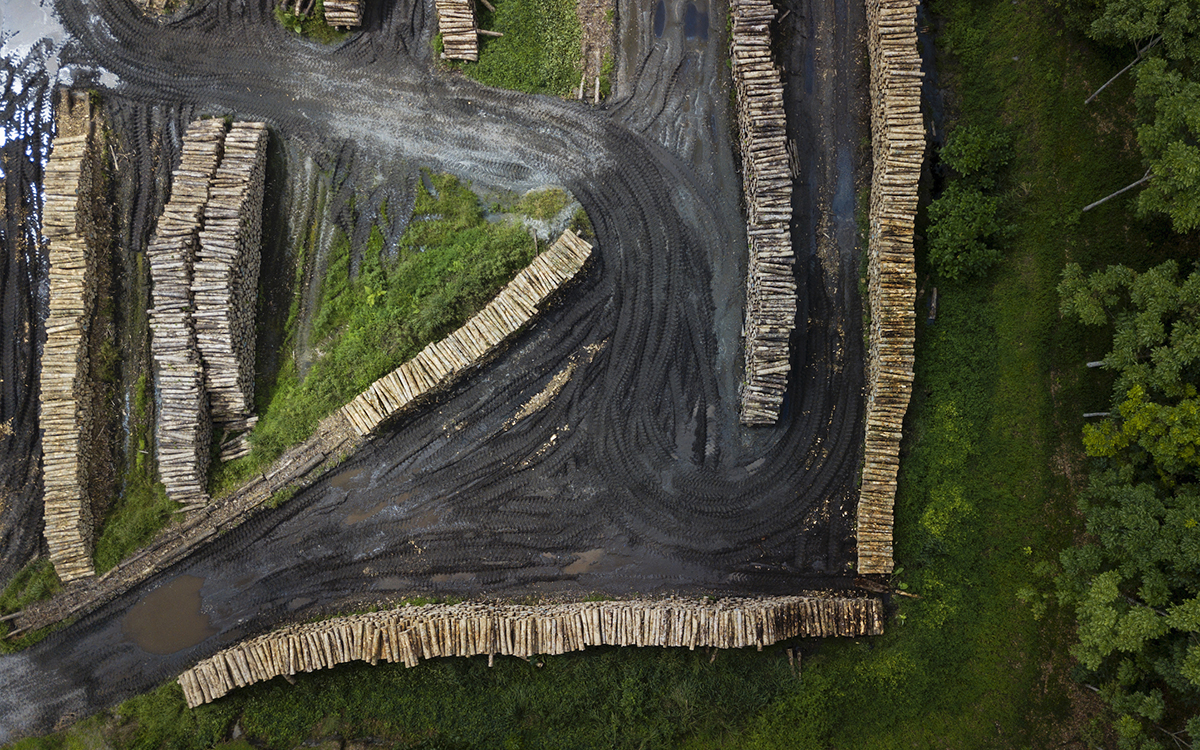
Aerial view of a timber operation in the Chocó region, Ecuador. | Photo by Lucas Bustamante
Although SARS-CoV-2 is new to science, its emergence came as little surprise to experts—it fit the profile of previous spillover events. The virus was first identified in early January in Wuhan, China, where a case-cluster of pneumonia linked to a market that sold both domesticated and wild animals had emerged. Based on comparisons of the virus’s genetic sequence with those collected from a wide variety of wildlife and deposited in public databases, in some cases years earlier, we’ve concluded that the pathogen originated in bats. At some point in its evolution, it diverged from its ancestral form and picked up mutations that allowed for efficient human-to-human transmission. That set the stage for an outbreak to become a pandemic.
Despite what we know or suspect about the emergence of SARS-CoV-2, it’s still unclear exactly how and when this virus jumped into humans. It’s not known, for example, whether the pathogen came directly from a bat or passed through and underwent subsequent changes in another host animal, even other humans, before evolving its pandemic potential. Understanding the exact route of transmission requires tracing the virus back in time to identify the first human or humans to become infected, as well as what animal or animals they interacted with that might have been carrying the virus or its closest relative. It may already be too late for this type of leg work to reveal the path that SARS-CoV-2 took.
Identifying where and how humans and other potential hosts interact is critical to understanding and ultimately preventing future outbreaks of known pathogens. But perhaps more important, tracking the routes of transmission for many different infectious diseases has begun to reveal where and how spillover events happen in general, and what might lead to the next one. We’ve found, for example, that the routes viruses take from nonhuman into human hosts typically lie along a continuum of urbanization. From game killed by a hunter deep in the jungle, through wildlife traded in population centers, to agricultural slaughter or the bite of an invasive mosquito, humans are increasingly encountering viruses they normally wouldn’t—viruses that have the potential to become deadly pathogens.
These routes of transmission and the pathogens they give rise to are growing in number at our hand. Humans are providing an array of new opportunities practically everywhere we go. We’re altering habitats, expanding our populations and those of domesticated animals and invasive species; and we’re increasing the frequency of interactions between people and wildlife through development, hunting, and agricultural practices that entice wild animals to rely on human crops. As author David Quammen wrote recently in The New York Times, “We disrupt ecosystems, and we shake viruses loose from their natural hosts. When that happens, they need a new host. Often, we are it.”
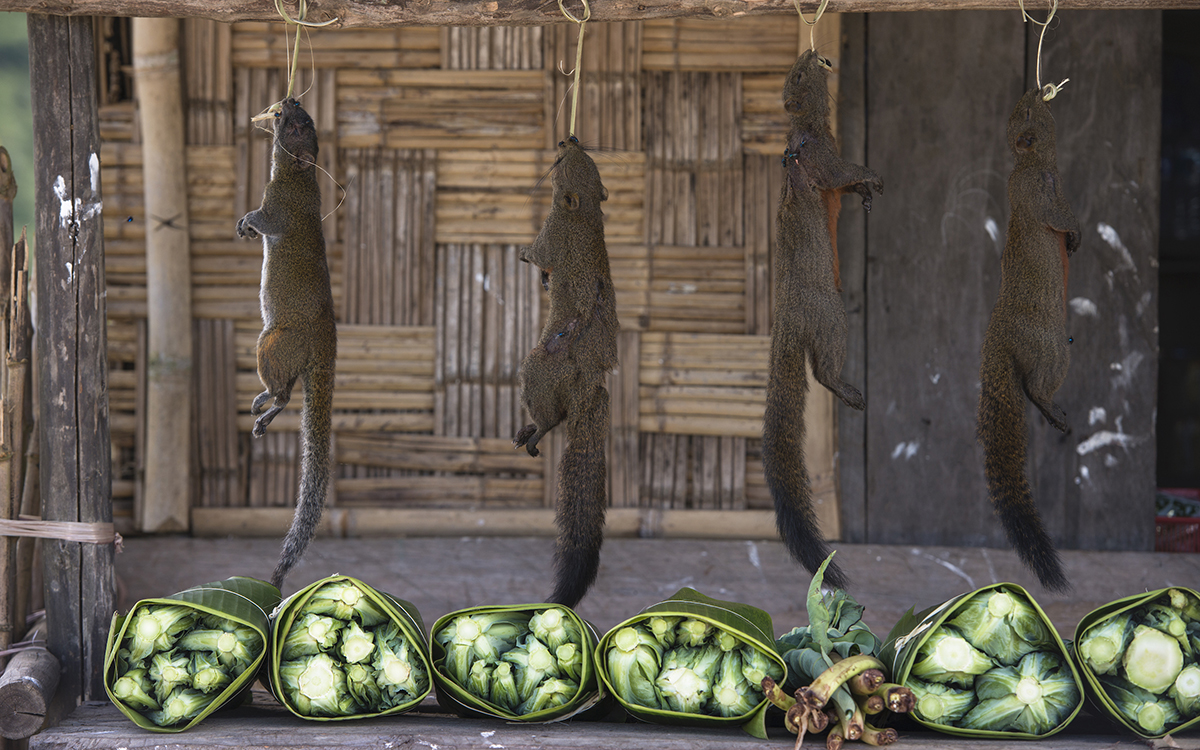
Squirrels for sale at a market in Nagaland, India. | Photo by Pete Oxford
Our continued encroachment into natural systems accelerates not only the opportunities for potential pathogens to spill over into humans but also their ability to evolve efficient human-to-human transmission. Not all microbes that spill over necessarily have the capacity to transmit efficiently among humans—they often must acquire these characteristics through evolution. This gain of function and the speed with which it can be attained can be facilitated by newfound host density. In short, large concentrations of humans, domesticated animals, or human-associated invasive species can enable emergent infectious disease agents to more efficiently capitalize on available opportunities.
Evolutionary biologist Jared Diamond coined the term viral chatter to describe the process by which viruses spill over into humans, detected or otherwise, but don’t necessarily go any further. They are, so to speak, testing the waters. In the case of COVID-19, health professionals in Wuhan early on assumed that they were witnessing viral chatter: animal-to-human transmission that was essentially limited and incapable of jumping from person to person. They were wrong. The virus had already overcome its functional limitations by the time they had detected it.
What are these critical functional gains, and how do our actions enable pathogens to overcome their biological limits to live and reproduce and continue their spread to subsequent human hosts? For viruses, the limits are the result of their way of life as obligate intracellular parasites, which means they need host cells to reproduce. Viruses are tiny packages of genetic material bristling with proteins that enable them to enter a host cell where they then copy their genetic code and produce new viruses. To enter the host cell, virus proteins act like a key and bind very specifically to the host cell receptor, the lock.
The first limit that a virus must typically overcome if it has successfully jumped from a nonhuman animal into a human is the poor fit between its key and the new host’s lock. Once the key has been refined enough through natural selection to open the lock, the virus then has to actually enter the host cell and undergo a series of steps to produce viable progeny. These interactions with the host cell can be very specific, impacting both the course of the disease and the transmissibility of the virus to the next human. To have the potential to create a pandemic, these spillover viruses need to have, or evolve, the ability to unlock the door, get inside the cell, and essentially have a successful house party.
Epidemiologists are interested in these gains of function because they dramatically influence a virus’s ability to spread through a population. They measure this potential with a value known as the reproductive ratio, which is the number of new infections that a single infected person gives rise to.
Unfortunately, viruses gain these functions in different ways, not necessarily involving the same kinds of changes in the same kinds of genes or functional groups of genes. Still, although we might not always know which mutations are necessary to change a dilettante virus, the chattering kind, into the cause of the next pandemic, we do know that humans can aid the process by providing both ecological and evolutionary opportunities.
Industrial agriculture, for example, has facilitated the emergence of novel influenza strains; high-density poultry farms in Southeast Asia enabled the highly pathogenic avian influenza (HPAI) H5N1 to jump from wild birds into domesticated fowl, where it then became more virulent; swine flu (H1N1) emerged in 2009 from industrial hog farms in the southern United States and Mexico because multiple strains mixed to create a new combination. In the SARS family tree, Middle Eastern Respiratory Syndrome virus (MERS, Middle East, 2012–13), SARS-CoV (China, 2002), and SARS-CoV-2, as well as up to four endemic human coronaviruses (HCoV, Asia, last 100 years) have each had the ecological opportunity to spill over into humans and have acquired the evolutionary changes necessary for human-to-human transmission, most likely due to the accessibility of lots of humans for those viruses with initial opportunities to test the waters in.
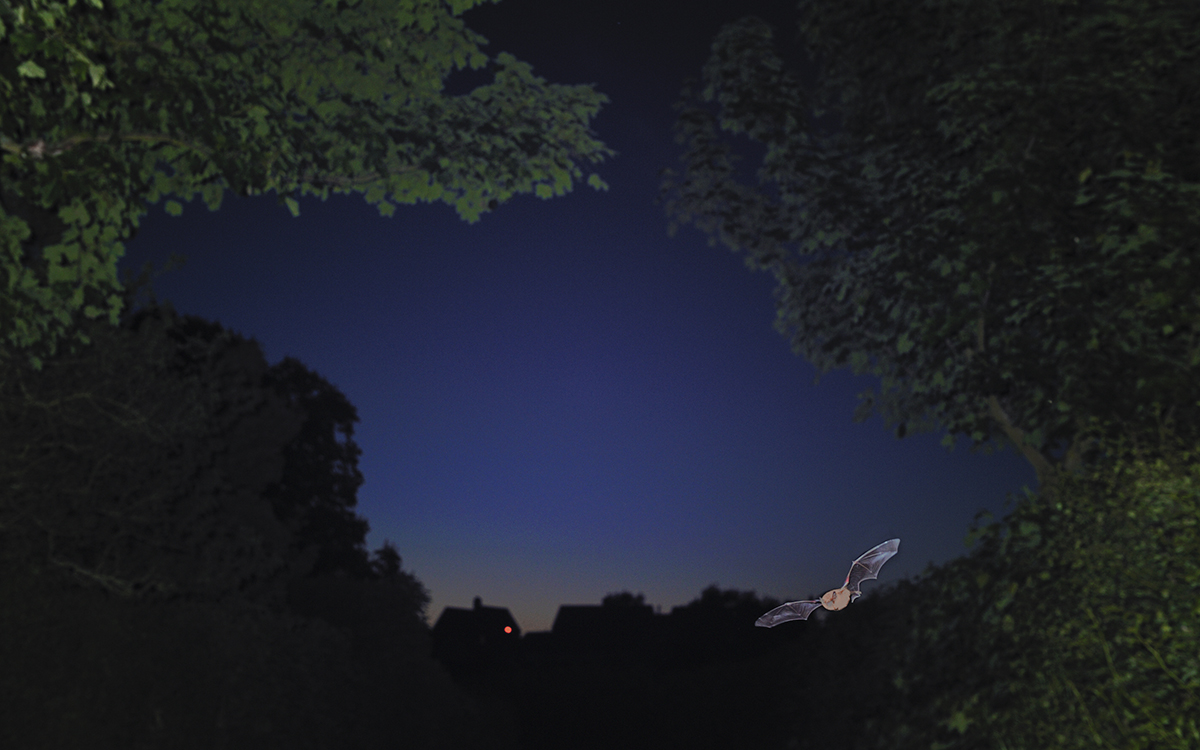
Bat over Berwickshire, Scotland. | Photo by Laurie Campbell
Today we are facing a pandemic of our own making. We have eroded ecological boundaries between humans and natural systems through wildlife trade and have introduced a novel viral agent into human networks that are both locally dense and globally vast, where it was able to evolve efficient human-to-human transmission. Given the conditions that gave rise to the current pandemic, as well as recent history, there is little question that we are on a trajectory toward similar outbreaks in the future. Expanding human populations and increasing globalization, greedy economic forces, social pressures, poverty, and dwindling food security will result in continued human encroachment and habitat degradation, tipping balanced and diverse ecosystems into hyper-dominant monocultures of humans and domesticated and invasive species, including pathogens.
Given that so many infectious diseases have emerged from nature, some people might conclude that we’d be better off if we simply paved over the natural world and eliminated all those reservoirs of potential disease. Imagine, though, the simplified, purified world that would result—nothing but humans, our crops, and our livestock, along with the rats, cockroaches, and pigeons that would inevitably persist.
I’m guessing that most people wouldn’t want to live in such a world. More importantly, such unnatural conditions would actually foster more disease and pandemics rather than fewer. Systems dominated by a mere handful of species are easily invaded by pathogens. Industrial, monoculture farms must fight an ongoing arms race against pests and pathogens with increasingly powerful weapons such as toxic chemicals, copious antibiotics, and genetic modifications. In contrast, small organic, mixed-species farms garden for diversity and present a more challenging target for fast-evolving microbes, rather than a bullseye of evolutionary opportunity.
Similarly, invasive mosquito species that flock to the roadways, clearcuts, rice paddies, and urban sprawl of human encroachment out-compete diverse communities of disease-free native mosquitoes, bringing more malaria and viral diseases into human populations. The emergence of the Zika virus from a low-level and diverse jungle into the invasive mosquito species Aedes aegypti and large populations of humans illustrates yet another pathogen’s evolutionary capacity to respond to the opportunities provided by degraded environments.
In the case of SARS-CoV-2, it took mere evolutionary moments for a virus circulating in a population of wild bats to adopt the human body as its new habitat. Eliminate bats, you say, along with their roles as pollinators or insectivores? Before we travel down this slippery slope, let us instead consider an alternative, in which rather than eliminating or sanitizing nature, we change our relationship with it.
Devastating as it is, COVID-19 is teaching us valuable lessons about how we can collectively respond to a pandemic. Core to this response has been the unprecedented democratization of data and scientific information. Impacted countries worldwide are publicly reporting daily cases and deaths, including georeferencing to help the world track the spread of the disease. At the time of this writing, 67,000 genomes of the infecting viruses have been posted online to GISAID to track its molecular epidemiology, to understand SARS-CoV-2 origins, variability, and evolution, and to help design diagnostics, vaccines, and therapeutics.
Since SARS-CoV-2’s discovery, to date, scientists around the world have released more than 6,600 preprints and published 33,650 peer-reviewed studies, providing critical insights into the virus’s biology, epidemiology, clinical course, immunogenicity, and potential treatments. Seed changes in health care infrastructure coupled with new social media technologies are permanently advancing our future capacity to detect and respond to emerging viral threats. The question is, as we develop proximate solutions, can we be similarly innovative and collectively impactful in finding ultimate solutions to avoid or mitigate future pandemics. Can we rewrite our relationship with nature?
This has already begun. With powerful new tools such as iNaturalist, Seek, and eBird, we are democratizing information about how biodiversity is distributed in nature. Using environmental DNA approaches, we are tracking viral diversity in the world, from SARS-CoV-2 progenitors in bats and pangolins to the origins of many mosquito-borne viruses. All this information tells the same story: When humans encroach upon and modify natural systems, new diseases can emerge because of the ecological and evolutionary opportunities that highly diverse, quickly evolving pathogens can take advantage of. But finding the ultimate solutions is not always straightforward and requires that we identify the drivers of human encroachment in the first place. In Madagascar, for example, people are increasingly turning to farming and hunting native wildlife, simply because they lack any other options. To address the problem, California Academy of Sciences’ and Malagasy teams are working to scale up the practice of insect farming as a sustainable source of protein to address food insecurity and reduce the pressure on the forest and its native species.
Although projects like this are relatively small in scale, it is these types of approaches that will help to prevent future pandemics. We can no longer ignore the ecological imbalances that lead to spillover events. We can no longer simply wait for future pandemics to flare up before we respond, as we’ve done with COVID-19. The cost of human lives and livelihoods is simply too great. We must instead address the environmental imbalances that have led to outbreaks time and time again, and will continue to do so until they’re corrected.
After all, the microbial diversity that makes up a significant part of our world is not in itself a threat. Instead, it’s the ways in which we interact with those potential pathogens and provide them with newfound opportunities to evolve and expand into human niches that is the ultimate driver of pandemic potential, one that we can and should control before it’s too late.
This story originally appeared in bioGraphic, an online magazine about nature and sustainability powered by the California Academy of Sciences.
 The Magazine of The Sierra Club
The Magazine of The Sierra Club



